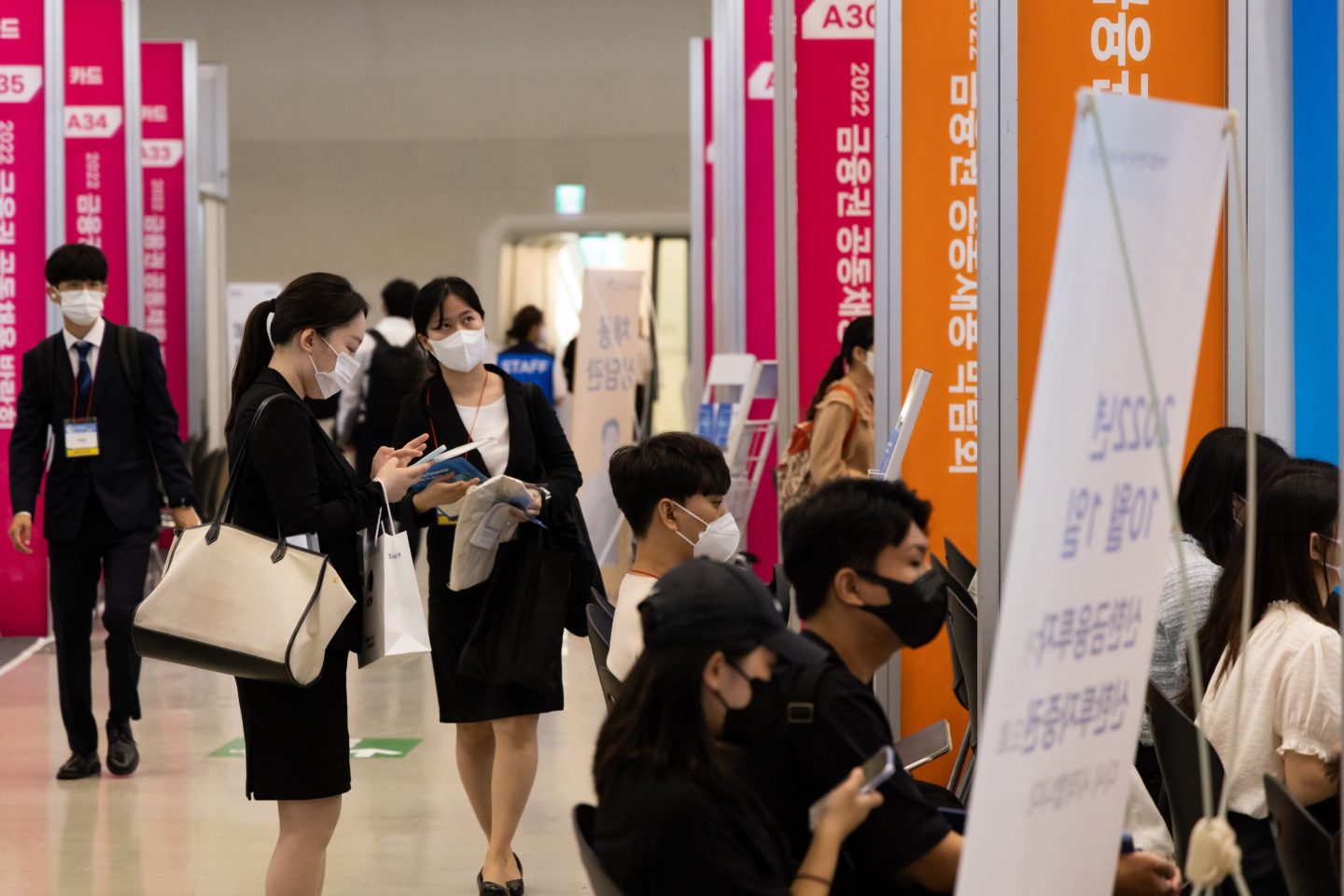
2021年,,韓國(guó)是世界上生育率最低的國(guó)家,其生育率甚至低于2020年,,2020年該國(guó)生育率排名倒數(shù)第一,。
韓國(guó)統(tǒng)計(jì)局表示,2021年,,韓國(guó)女性一生中平均生育0.81個(gè)孩子,,連續(xù)第六年下降。
韓國(guó)人口普查局本周公布的數(shù)據(jù)顯示,,同期韓國(guó)新生兒數(shù)量驟降至26萬(wàn),,創(chuàng)歷史新低,較上年同期下降4.3%,。這是該國(guó)出生人口連續(xù)第二年低于30萬(wàn),。
韓國(guó)是許多正在經(jīng)歷出生率和生育率下降的發(fā)達(dá)國(guó)家之一。例如,,2020年中國(guó)香港的生育率為0.9,,而新加坡為1.1。
美國(guó)的新生兒數(shù)量在2021年實(shí)際增長(zhǎng)了1%,,達(dá)到360萬(wàn),。
壓力源
去年,網(wǎng)飛(Netflix)的韓國(guó)系列電視劇《魷魚(yú)游戲》風(fēng)靡全球,。在節(jié)目中,,456名負(fù)債累累的參賽者在致命游戲中競(jìng)爭(zhēng),只為獲得贏取4000萬(wàn)美元并消除債務(wù)的機(jī)會(huì)。
該電視劇的主題在世界范圍內(nèi)引起了共鳴,,對(duì)韓國(guó)年輕人來(lái)說(shuō)尤其如此,。近年來(lái),他們?cè)陧n國(guó)社會(huì)經(jīng)濟(jì)地位上升的機(jī)會(huì)急劇下降,。就業(yè)競(jìng)爭(zhēng)加劇,,房?jī)r(jià)飆升,年輕人轉(zhuǎn)向“快速致富”計(jì)劃,,比如大舉借債,,投資加密貨幣和股票,以及在線(xiàn)賭博,。
韓國(guó)年輕職場(chǎng)人士還面臨著巨大的社會(huì)壓力和工作壓力,,比如長(zhǎng)時(shí)間工作以及與老板和同事酗酒。對(duì)于職業(yè)女性來(lái)說(shuō),,職業(yè)壓力加劇——韓國(guó)超過(guò)一半的女性都在工作——她們不僅要把所有事情都做好,,還要遵守嚴(yán)格的審美標(biāo)準(zhǔn)和照顧家庭。
這些因素導(dǎo)致年輕人缺乏為人父母的欲望,。超過(guò)一半的韓國(guó)年輕人表示婚后沒(méi)有必要生孩子,。這一情況還加劇了該國(guó)的心理健康危機(jī);超過(guò)95%的人表示他們有壓力,,該國(guó)的自殺率在所有經(jīng)合組織國(guó)家中最高,。
在20世紀(jì)70年代,韓國(guó)每年的出生人口都徘徊在100萬(wàn)左右,。從那以后,,這個(gè)數(shù)字一直在下降。2017年,,這一數(shù)字首次跌破40萬(wàn),。
去年,該國(guó)每千人的出生人數(shù)也從2020年的5.3下降到5.1,,創(chuàng)歷史新低,。女性的平均生育年齡也從去年的33.1歲增加到2021年的33.4歲。
“人們結(jié)婚,、生育和撫養(yǎng)孩子到底有多難才能導(dǎo)致這個(gè)數(shù)字如此之低,?如果我們將此作為衡量基本生活的簡(jiǎn)要標(biāo)準(zhǔn),這是一個(gè)令人痛苦的數(shù)字,。”首爾漢陽(yáng)大學(xué)(Hanyang University)政策學(xué)教授李三植(Lee Samsik)在接受《紐約時(shí)報(bào)》采訪(fǎng)時(shí)表示,。
未來(lái)發(fā)展
2020年,,韓國(guó)首次出現(xiàn)人口自然減少現(xiàn)象,即死亡人數(shù)超過(guò)了新生兒人數(shù)。據(jù)聯(lián)合國(guó)估計(jì),,到本世紀(jì)末,,韓國(guó)5100萬(wàn)人口可能會(huì)減半。
在過(guò)去的幾年時(shí)間里,,韓國(guó)一直在努力尋找解決人口和勞動(dòng)力減少的辦法,。政府提倡讓更多的女性——以及機(jī)器人——進(jìn)入勞動(dòng)力市場(chǎng)。政府還出臺(tái)了補(bǔ)貼政策來(lái)鼓勵(lì)家庭多生孩子,,包括每生一個(gè)孩子就有1185美元的現(xiàn)金獎(jiǎng)勵(lì),,以及在孩子出生后的第一年每月提供224美元的補(bǔ)貼(到2025年將增加到373美元)。工作滿(mǎn)六個(gè)月的新生兒父母可以享受一年的帶薪育兒假,。但在實(shí)踐中,,由于職業(yè)污名,休陪產(chǎn)假的員工仍然很少,,而休產(chǎn)假的母親往往會(huì)因此受到雇主的懲罰,。
韓國(guó)的低生育率和女性勞動(dòng)參與率最終“反映出根深蒂固的社會(huì)規(guī)范,這一社會(huì)規(guī)范很難扭轉(zhuǎn),。未來(lái)幾十年勞動(dòng)力數(shù)量急劇下降是不可避免的,。”研究公司凱投宏觀(guān)(Capital Economics)的高級(jí)亞洲經(jīng)濟(jì)學(xué)家加雷思·萊瑟(Gareth Leather)在去年8月的一份報(bào)告中寫(xiě)道,。
這些補(bǔ)貼“可能在一定程度上有所幫助,,但我們懷疑它能產(chǎn)生巨大的影響。對(duì)父母的經(jīng)濟(jì)支持往往對(duì)生育影響很有限,?!比R瑟說(shuō)。
韓國(guó)已實(shí)施改革,,向移民勞工敞開(kāi)大門(mén),。然而,考慮到成為韓國(guó)公民面臨的挑戰(zhàn),,其人口中只有3%是在國(guó)外出生的,。公眾輿論也反對(duì)大規(guī)模移民進(jìn)入該國(guó)。
如果政府沒(méi)有采取重大干預(yù)措施,,該國(guó)可能會(huì)在未來(lái)五年左右出現(xiàn)嚴(yán)重的勞動(dòng)力短缺,;韓國(guó)健康與社會(huì)事務(wù)研究所(Korea Institute for Health and Social Affairs)的人口統(tǒng)計(jì)學(xué)家李相林(Lee Sang-lim)告訴《紐約時(shí)報(bào)》,在三到四代人的時(shí)間內(nèi),,韓國(guó)人口可能會(huì)急劇下降,。(財(cái)富中文網(wǎng))
譯者:中慧言-王芳
2021年,韓國(guó)是世界上生育率最低的國(guó)家,,其生育率甚至低于2020年,,2020年該國(guó)生育率排名倒數(shù)第一,。
韓國(guó)統(tǒng)計(jì)局表示,2021年,,韓國(guó)女性一生中平均生育0.81個(gè)孩子,,連續(xù)第六年下降。
韓國(guó)人口普查局本周公布的數(shù)據(jù)顯示,,同期韓國(guó)新生兒數(shù)量驟降至26萬(wàn),,創(chuàng)歷史新低,較上年同期下降4.3%,。這是該國(guó)出生人口連續(xù)第二年低于30萬(wàn),。
韓國(guó)是許多正在經(jīng)歷出生率和生育率下降的發(fā)達(dá)國(guó)家之一。例如,,2020年中國(guó)香港的生育率為0.9,,而新加坡為1.1。
美國(guó)的新生兒數(shù)量在2021年實(shí)際增長(zhǎng)了1%,,達(dá)到360萬(wàn),。
壓力源
去年,網(wǎng)飛(Netflix)的韓國(guó)系列電視劇《魷魚(yú)游戲》風(fēng)靡全球,。在節(jié)目中,,456名負(fù)債累累的參賽者在致命游戲中競(jìng)爭(zhēng),只為獲得贏取4000萬(wàn)美元并消除債務(wù)的機(jī)會(huì),。
該電視劇的主題在世界范圍內(nèi)引起了共鳴,,對(duì)韓國(guó)年輕人來(lái)說(shuō)尤其如此。近年來(lái),,他們?cè)陧n國(guó)社會(huì)經(jīng)濟(jì)地位上升的機(jī)會(huì)急劇下降,。就業(yè)競(jìng)爭(zhēng)加劇,房?jī)r(jià)飆升,,年輕人轉(zhuǎn)向“快速致富”計(jì)劃,,比如大舉借債,投資加密貨幣和股票,,以及在線(xiàn)賭博,。
韓國(guó)年輕職場(chǎng)人士還面臨著巨大的社會(huì)壓力和工作壓力,比如長(zhǎng)時(shí)間工作以及與老板和同事酗酒,。對(duì)于職業(yè)女性來(lái)說(shuō),,職業(yè)壓力加劇——韓國(guó)超過(guò)一半的女性都在工作——她們不僅要把所有事情都做好,還要遵守嚴(yán)格的審美標(biāo)準(zhǔn)和照顧家庭,。
這些因素導(dǎo)致年輕人缺乏為人父母的欲望,。超過(guò)一半的韓國(guó)年輕人表示婚后沒(méi)有必要生孩子。這一情況還加劇了該國(guó)的心理健康危機(jī),;超過(guò)95%的人表示他們有壓力,,該國(guó)的自殺率在所有經(jīng)合組織國(guó)家中最高,。
在20世紀(jì)70年代,韓國(guó)每年的出生人口都徘徊在100萬(wàn)左右,。從那以后,這個(gè)數(shù)字一直在下降,。2017年,,這一數(shù)字首次跌破40萬(wàn)。
去年,,該國(guó)每千人的出生人數(shù)也從2020年的5.3下降到5.1,,創(chuàng)歷史新低。女性的平均生育年齡也從去年的33.1歲增加到2021年的33.4歲,。
“人們結(jié)婚,、生育和撫養(yǎng)孩子到底有多難才能導(dǎo)致這個(gè)數(shù)字如此之低?如果我們將此作為衡量基本生活的簡(jiǎn)要標(biāo)準(zhǔn),,這是一個(gè)令人痛苦的數(shù)字,。”首爾漢陽(yáng)大學(xué)(Hanyang University)政策學(xué)教授李三植(Lee Samsik)在接受《紐約時(shí)報(bào)》采訪(fǎng)時(shí)表示,。
未來(lái)發(fā)展
2020年,,韓國(guó)首次出現(xiàn)人口自然減少現(xiàn)象,即死亡人數(shù)超過(guò)了新生兒人數(shù),。據(jù)聯(lián)合國(guó)估計(jì),,到本世紀(jì)末,韓國(guó)5100萬(wàn)人口可能會(huì)減半,。
在過(guò)去的幾年時(shí)間里,,韓國(guó)一直在努力尋找解決人口和勞動(dòng)力減少的辦法。政府提倡讓更多的女性——以及機(jī)器人——進(jìn)入勞動(dòng)力市場(chǎng),。政府還出臺(tái)了補(bǔ)貼政策來(lái)鼓勵(lì)家庭多生孩子,,包括每生一個(gè)孩子就有1185美元的現(xiàn)金獎(jiǎng)勵(lì),以及在孩子出生后的第一年每月提供224美元的補(bǔ)貼(到2025年將增加到373美元),。工作滿(mǎn)六個(gè)月的新生兒父母可以享受一年的帶薪育兒假,。但在實(shí)踐中,由于職業(yè)污名,,休陪產(chǎn)假的員工仍然很少,,而休產(chǎn)假的母親往往會(huì)因此受到雇主的懲罰。
韓國(guó)的低生育率和女性勞動(dòng)參與率最終“反映出根深蒂固的社會(huì)規(guī)范,,這一社會(huì)規(guī)范很難扭轉(zhuǎn),。未來(lái)幾十年勞動(dòng)力數(shù)量急劇下降是不可避免的?!毖芯抗緞P投宏觀(guān)(Capital Economics)的高級(jí)亞洲經(jīng)濟(jì)學(xué)家加雷思·萊瑟(Gareth Leather)在去年8月的一份報(bào)告中寫(xiě)道,。
這些補(bǔ)貼“可能在一定程度上有所幫助,,但我們懷疑它能產(chǎn)生巨大的影響。對(duì)父母的經(jīng)濟(jì)支持往往對(duì)生育影響很有限,?!比R瑟說(shuō)。
韓國(guó)已實(shí)施改革,,向移民勞工敞開(kāi)大門(mén),。然而,考慮到成為韓國(guó)公民面臨的挑戰(zhàn),,其人口中只有3%是在國(guó)外出生的,。公眾輿論也反對(duì)大規(guī)模移民進(jìn)入該國(guó)。
如果政府沒(méi)有采取重大干預(yù)措施,,該國(guó)可能會(huì)在未來(lái)五年左右出現(xiàn)嚴(yán)重的勞動(dòng)力短缺,;韓國(guó)健康與社會(huì)事務(wù)研究所(Korea Institute for Health and Social Affairs)的人口統(tǒng)計(jì)學(xué)家李相林(Lee Sang-lim)告訴《紐約時(shí)報(bào)》,在三到四代人的時(shí)間內(nèi),,韓國(guó)人口可能會(huì)急劇下降,。(財(cái)富中文網(wǎng))
譯者:中慧言-王芳
South Koreans are having so few children that their country had the world’s lowest fertility rate in 2021, even lower than the preceding year in which the nation also came in dead last.
South Korean women averaged 0.81 births during their lifetimes in 2021—the sixth straight year of decline, says Statistics Korea.
Over the same period, the number of newborns in the country plunged to a new, all-time low of 260,000, down 4.3% from the year prior, according to South Korea census bureau data released this week. It’s the second consecutive year that the country’s childbirths dipped below 300,000.
South Korean is among many developed nations that are experiencing a decline in childbirths and fertility rates. For example, Hong Kong had a fertility rate of 0.9 in 2020 while Singapore’s was at 1.1.
In the U.S., the number of newborns actually rose 1% in 2021 to 3.6 million.
Stressors
Last year, South Korean Netflix series?Squid Game took the world by storm. In the show, 456 indebted contestants compete in deadly games for a chance to win $40 million and erase their debts.
Its themes resonated worldwide, but particularly for young South Koreans, whose chances at moving up the country’s socioeconomic ladder have plummeted in recent years. Job competition has intensified, home prices have skyrocketed, and young people have turned to ‘get rich quick’ schemes like bingeing on debt to invest in cryptocurrencies and stocks, along with online gambling.
Young Korean professionals also face significant societal pressures to conform, and work pressures like long hours and heavy drinking sessions with bosses and coworkers. These professional pressures are exacerbated for working women—over half of South Korea’s female population are in the workforce—who are expected to do all of the above, but also adhere to rigid beauty standards and take care of the home and family.
These factors have translated into a lack of desire to become parents among young people. Over half of young Koreans say having children is unnecessary after marriage. It has also exacerbated the country’s mental health crisis; over 95% of the population say they’re stressed and the country has the highest suicide rate among all OECD nations.
During the 1970s, South Korea’s annual number of childbirths hovered at around 1 million. Since then, it has consistently declined. In 2017, that figure fell below 400,000 for the first time.
Last year, the nation’s number of births per 1,000 people, also plunged to a new, all-time low of 5.1, compared to 5.3 in 2020. The average age of a woman giving birth has also increased to 33.4 in 2021, compared to 33.1 in a year earlier.
“How difficult must people find it to get married, give birth, and raise children for this number to be so low? If we take this as a compressed measure of basic life, it’s a troublesome figure,” Lee Samsik, a professor of policy at Seoul’s Hanyang University, told the?New York Times.?
Road ahead
In 2020, South Korea experienced its first natural population decline as its number of deaths surpassed the number of newborns. By the end of this century, South Korea’s population of 51 million could halve, according to United Nations estimates.
In the last few years, the nation has scrambled to find solutions to deal with its shrinking population and labor force. The government has advocated for bringing more women—and robots—into its workforce. It has also introduced subsidies to encourage families to have more children, including a cash bonus of $1,185 for every child born, and a monthly grant of $224 for the first year of a child’s life (this will increase to $373 by 2025). New parents who have been in their job for six months are entitled to one year of paid parental leave. But in?practice, workers taking paternity leave is still rare due to professional stigma while mothers taking maternity leave are often penalized by their employers for doing so.
South Korea’s low fertility rate and female labor participation rates ultimately “reflect entrenched social norms that will be difficult to turn around. A sharp decline in the workforce over the next couple of decades is inevitable,” Gareth Leather, senior Asia economist at research firm Capital Economics, wrote in a note last August.
The subsidies “may help at the margin, but we doubt it would make a huge difference. Financial support for parents tends to have a limited impact on fertility,” Leather said.
South Korea has implemented reforms to open its doors to migrant laborers. Yet only 3% of its population is foreign-born, given the challenges of becoming a South Korean citizen. Public popular opinion is also stacked against mass immigration into the country.
In the absence of a major government intervention, the country will likely experience a crippling labor shortage by the middle of the next decade; and within three to four generations, the national population could drop dramatically, Lee Sang-lim, a demographer with the Korea Institute for Health and Social Affairs, told the?New York Times.?






